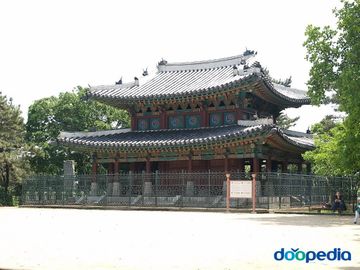부산진성
| 부산진성 Busanjinseong Fortress |
|
| 대표명칭 | 부산진성 |
|---|---|
| 영문명칭 | Busanjinseong Fortress |
| 한자 | 釜山鎭城 |
| 주소 | 부산광역시 동구 자성로 99 (범일동) |
| 지정(등록) 종목 | 부산광역시 기념물 |
| 지정(등록)일 | 1972년 6월 26일 |
| 분류 | 유적건조물/정치국방/성/성곽 |
| 시대 | 조선시대 |
| 수량/면적 | 24,198㎡ |
| 웹사이트 | "부산진성", 국가문화유산포털, 문화재청. |
|
|
|
- 2020.01. '부산진지성' → '부산진성'으로 명칭 변경.
목차
해설문
국문
2019
임진왜란 때인 1593년(선조 26) 일본군에 의해 부산진성이 함락된 후, 일본 장수 모리 테루모토〔毛利輝元〕가 부산진성을 허물고 진성의 서북쪽 산 정상에 본성(本城)인 증산왜성(倭城)을 쌓았다. 그리고 동남쪽 해안가에는 본성을 방어하기 위하여 지성(支城)인 자성대왜성(倭城)을 쌓았다. 임진왜란이 끝난 조선후기 조선 수군은 자성대왜성을 고쳐서 부산진첨사영(釜山鎭僉使營)으로 사용하였다. 당시 성의 동서남북에 각각 문루(門樓, 성문 위에 세운 높은 집 또는 다락)가 있었으며 진동문(鎭東門), 금루관(金壘關), 진남문(鎭南門), 구장루(龜藏樓)라 하였다. 일제강점기에 시가지 정비계획에 따라 성이 철거되면서 옛 모습은 거의 사라졌지만, 현재 최고 10m정도 높이로 비스듬히 경사진 일본식 성벽이 공원 곳곳에 남아 있다. 1974년 부산진지성 정화공사로 동문인 진동문, 서문인 금루관, 장대인 진남대(鎭南臺)가 복원되었다. 진남대 옆에는 임진왜란 때 참전한 명나라의 장군 천만리(千萬里)의 후손이 세운 ‘천만리영양천공비(千萬里潁陽千公碑)’가 남아있고, 동문 위쪽으로는 고려말 왜구 토벌에 공을 세운 최영(崔瑩)장군 비각이 보존되어 있다. 부산진지성(부산진성)은 당시 일본식 성곽의 축조수법뿐만 아니라 왜성을 이용한 부산진성의 축조수법 연구에 좋은 자료가 되고 있다.
2020
부산진(釜山鎭)은 조선 태종 7년(1407) 경상좌도(慶尙左道) 수군의 사령부로서 동남해안의 방어임무를 맡았으며 성종 21년(1490) 병선의 정박처로서 수군과 물자를 보호하기 위하여 부산진성을 증산(甑山) 아래에 쌓았다.
선조 25년(1592) 임진왜란(壬辰倭亂) 때 함락되고 일본군 장수 모리 테루모토(毛利輝元)에 의해 허물어져 증산 정상에 본성(本城)인 증산왜성(倭城)을 동남쪽 해안가에는 본성을 방어하기 위한 지성支城: 원래의 성 밖에 보조로 쌓은 성, 을 쌓았다.
임진왜란이 끝난 뒤 선조 40년(1607) 조선 수군은 증산왜성의 지성으로 진(鎭)을 옮겨 부산진성으로 사용하였다. 당시 부산진성의 둘레는 약 2.25㎞로 동서남북에는 문을 두어 각각 진동문(鎭東門), 금루관(金壘關), 진남문(鎭南門), 구장루(龜藏樓)라 불렀으며 문루門樓: 성문 위에 세운 높은 집 또는 다락를 두었다. 그리고 성내 정상부 자성대(子城臺)에는 정유재란(丁酉再亂) 때 참전한 명나라 장수 만세덕(萬世德)을 추모하는 만공단(萬公壇)이 조성되었다.
일제강점기 시가지 정비 계획에 따라 성을 철거하면서 옛 모습이 거의 사라졌는데, 1974년 부산진성 정화 공사로 동문인 건춘문(建春文,구 진동문), 서문인 금루관, 장대(將臺)인 진남대(鎭南臺)가 복원되었다.
부산진성은 죽음을 무릅쓰고 나라를 지킨 선열(先烈)들과 조선수군의 5백년 역사를 간직한 곳이다. 또한, 임진왜란 때 쌓은 왜성과 이후 왜성을 이용한 조선 후기 수군진성에 관한 연구 자료로서도 그 가치가 크다.
영문
Busanjinjiseong Fortress
2019
This stone fortress was constructed in 1593 by the Japanese military when they occupied the Busan area during the Japanese invasions of 1592-1598.
Prior to this, Busanpo Port had been protected by a Korean-built fortress. But the Japanese troops led by Mori Terumoto demolished it and rebuilt a Japanese-style fortress to use as their main defense during the war. They also constructed a secondary fortress to aid in the defense of the area. After the war, the Joseon Navy renovated the secondary fortress to use it as their headquarters, which is today’s Busanjinjiseong Fortress. The main fortress, however, was completely destroyed.
During the Japanese colonial period (1910-1945), all but some sections of wall were destroyed due to a downtown renovation project. The remaining walls measure from 1.5 to 10 m in height. In 1974, an east gate, west gate, and command post were newly built.
Next to the command post is a monument commemorating General Cheon Man-ri (1583-?), a general who came from Ming China to assist the Joseon troops fighting against the Japanese. Next to the east gate is the commemorative pavilion of General Choe Yeong (1316-1388) who defeated the Japanese pirates in the late period of the Goryeo dynasty (918-1392).
2020
This stone fortress was constructed by the Japanese military when they occupied the Busan area during the Japanese invasions of 1592-1598.
Since 1407, Busanpo Port was the site of the Korean navy headquarters of East Gyeongsang-do Province, which guarded the southeast coast of the Korean Peninsula. In 1490, a fortress named Busanjinseong was built to help defend the headquarters. However, in 1592, Japanese troops led by Mori Terumoto demolished the fortress and rebuilt a Japanese-style fortress to use as their main stronghold during their invasions. They also constructed a secondary fortress to aid in the defense of the area. After the war, in 1607, the Korean Navy renovated the secondary fortress to use it as their headquarters. The main fortress, however, was completely destroyed.
During the Japanese colonial period (1910-1945), most of the wall was destroyed due to a downtown renovation project. In 1974, an east gate, west gate, and command post were newly built.
Next to the command post is a monument commemorating Wan Shide (萬世德), a general from Ming China who assisted the Korean troops in their fight against the Japanese. Next to the east gate is the commemorative pavilion of General Choe Yeong (1316-1388) who defeated Japanese pirates in the late period of the Goryeo dynasty (918-1392).
영문 해설 내용
2019
임진왜란 때인 1593년 부산 지역에 주둔하던 일본군이 일본식으로 쌓은 석성이다.
원래 이 지역에는 부산포를 지키는 조선의 성곽이 있었다. 모리 테루모토가 이끌던 일본군이 원래 있던 성곽을 허물고 왜성(본성)을 새로 쌓았으며, 이곳에는 본성을 방어하기 위한 지성을 쌓았다. 전쟁이 끝난 이후에는 조선 수군이 지성을 고쳐서 부산진지성을 쌓았고 관아로 사용했다. 본성은 완전히 사라졌다.
일제강점기에 시가지 정비계획에 따라 일부 성벽만을 남기고 성이 철거되었다. 현재 남아 있는 성벽의 높이는 최저 1.5m, 최고 10m이다. 1974년에는 동문, 서문, 장대를 새로 지었다.
장대 옆에는 명나라 출신으로 임진왜란에 참전하기 위해 조선에 왔던 천만리 장군을 기리는 비석이 세워져 있다. 동문 옆에는 고려 말 왜구를 토벌한 최영 장군의 비각이 있다.
2020
임진왜란 당시 부산 지역에 주둔하던 일본군이 일본식으로 쌓은 석성이다.
1407년 경상좌도 수군의 사령부가 부산포에 설치되어 동남해안을 방어했으며, 1490년에는 사령부를 보호하기 위한 부산진성을 쌓았다. 그러나 1592년 모리 테루모토가 이끌던 일본군이 성곽을 허물고 왜성(본성)을 새로 쌓았으며, 본성을 방어하기 위한 지성도 쌓았다. 전쟁이 끝난 이후에는 조선 수군이 지성을 고쳐서 부산진성으로 사용했다. 그러나 본성은 완전히 사라졌다.
일제강점기에 시가지 정비계획에 따라 일부 성벽만을 남기고 성이 철거되었다. 1974년에는 동문, 서문, 장대를 새로 지었다.
장대 옆에는 명나라 출신으로 임진왜란에 참전하기 위해 조선에 왔던 천만리 장군을 기리는 비석이 세워져 있다. 동문 옆에는 고려 말 왜구를 토벌한 최영 장군의 비각이 있다.
참고
- "'부산진지성→부산진성' 이름 되찾았다", 부산일보, 2020.01.19.]
